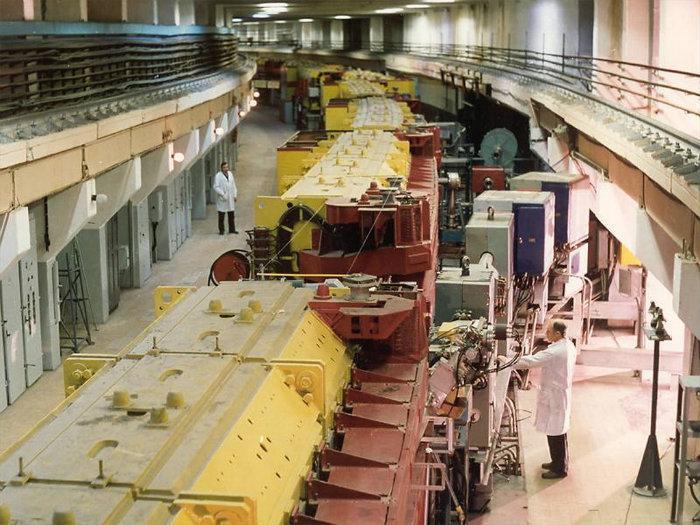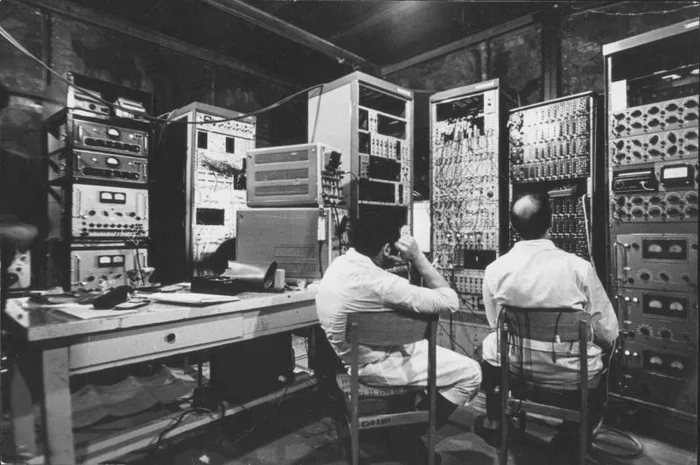Proton accelerator "U-70": the secret of the collider in Protvino
Just 100 kilometers from Moscow, near the town of Protvino, deep underground lies a forgotten giant — an accelerator complex on superconducting magnets. It is 21 kilometers long, up to 60 meters deep, and its cost is estimated at tens of billions of rubles. But they will not tell about this object on TV or write about it in textbooks.
Secret city and the birth of the collider
It all started in the 1960s. In the Moscow region, a secret settlement called Serpukhov-7 appeared, later renamed Protvino. The Institute of High Energy Physics, one of the most classified facilities of the late USSR, was located here.
Why was this place chosen?
Lack of seismic activity.
Remoteness from large settlements.
Unique geology for underground construction.
Proton synchrotron U-70: the pride of the Soviet Union
In 1967, the U-70 proton accelerator was launched — the most powerful at that time.
It accelerated particles almost to the speed of light.
The radiation generated (ultraviolet, IR, X-ray) made it possible to study matter at the level of atoms, cells, and even lower.
The weight of the magnetic system is more than 20,000 tons.
The accelerator's energy is a record for its time.
The deadly ray and the man who survived the unthinkable
In 1978, an incident occurred that became a legend.
Anatoly Bugorsky is a scientist who was caught in a proton beam.
Radiation at the entrance: 200,000 roentgens
At the exit: 300,000 roentgens
He survived, although doctors were preparing for the worst. He lost his hearing, suffered from seizures, but... returned to work!
In 2023, Bugorsky turned 81 years old.
The USSR discovers antimatter
In the 1970s, scientists discovered the nucleus of angelium-3, a rare particle, based on the U-70, which confirmed the existence of antimatter.
This became one of 20 official discoveries included in the register of discoveries of the USSR.
Megaproject: a 21-kilometer-long ring
In 1983, the most ambitious construction project of the USSR began:
Collider on superconducting magnets
Total length of the ring: 21 km (longer than the Moscow Ring Road!)
Depth: 20–60 m
Tunnel diameter: 5 m
Every 1.5 km, there are special halls with shafts where the equipment was located.
It was built using Canadian tunneling complexes, which drilled and lined with concrete segments at once.
The collapse of the USSR and the death of the project
By 1989, the tunnel was 80% complete.
They started building infrastructure:
water supply
sewage
power lines
multi-story technical buildings.
But at that time the USSR began to fall apart.
In 1994 the ring was officially closed - the accuracy was perfect.
96 billion rubles were allocated, but... most of the funds disappeared.
Tunnel conservation
After the 1998 crisis, the project was frozen forever.
But the tunnel is not abandoned:
Ventilation is working
Groundwater pumping is maintained
Standby lighting is on
Why wasn't it liquidated?
The facility is too dangerous to flood.
What does the ring hide underground?
The facility:
is located at a depth of up to 60 m
almost twice as long as the power transmission line
surrounded by myths and rumors
Some claim that the project will be revived as part of the "new science", while others talk about secret developments hidden in the tunnel. Some even believe that weapons of the future were tested there.
If the project had been completed, Russia could have outstripped even CERN.
The collider near Protvino - a lost opportunity or a sleeping giant that will wake up again someday?
At that time, the proton synchrotron was being assembled there, which was launched in 1967. The Soviet proton synchrotron was given the code name U-70. It was a cyclic accelerator of charged particles, consisting of a ring vacuum chamber in which charged particles, accelerated by a longitudinal pulse of an electric field, were accelerated to a speed close to the speed of light.
Powerful magnets, creating a magnetic field, directed the movement of particles along a closed trajectory. The total weight of just one magnetic system was over 20,000 tons. At the time of construction, the accelerator's energy was a record.
Soviet scientists tried to unravel the nature of matter with the help of the synchrotron. Charged particles moving at the speed of light caused radiation that was of great value to the scientific world. The radiation consisted of ultraviolet, infrared and X-ray, which is billions of times brighter than all known sources.
It is these radiations that help scientists study objects at the atomic level, examine all the structures of the cell and unknown particles of matter. In the 70s, an accident occurred at the facility. Due to a failure of the safety mechanisms, one of the magnets failed, as a result of which a beam of protons escaped from the accelerator tube and passed through the head of Anatoly Bugorsky, who was a specialist in the field of elementary particle physics.
The radiation dose at the entrance was 200 thousand roentgens, at the exit 300 thousand roentgens. The scientist saw an incredibly blinding flash. A beam of protons entered the occipital region of the head and exited in the area of the left wing of the nose. What is incredible and surprising is that I didn’t feel any pain at all. He assessed his condition after the piercing blow as tolerable and decided not to tell anyone about what had happened. He began to return to reality, in which he had been pierced through by a stream of radiation, only at night. By that time, signs of radiation sickness had already appeared.
Due to the high dose of radiation, doctors believed that the physicist would not survive until the next morning. The scientist was urgently hospitalized in the radiological clinic of Moscow. The staff was preparing for the worst outcome.
But, to the surprise of doctors, Bugorsky survived, having lost hearing in his left ear. At first, he was tormented by epileptic seizures with loss of consciousness. After recovery, the scientist continued to conduct experiments on the U-70 accelerators.
On July 13, Anatoly Petrovich encountered a malfunction that he had to fix. To check the equipment, he had to be in the accelerator.
The operators in the control room knew that a colleague was going to enter the chamber, he called and said that he would be there in five minutes. Five minutes later, the operators turned off the beam. But Bugorsky entered a little earlier.
During experiments with antimatter nuclei at the proton synchrotron in 1970, Soviet scientists discovered the nucleus of antihelium-3. This experiment confirmed the theory of the existence of antimatter.
The discovery was entered into the State Register of Discoveries of the Soviet Union under number 104. During the work, 20 new intra-atomic particles were discovered. Due to this, new phenomena of the physics of the microworld were recorded, including the Serpukhov effect, which confirmed the fractional composition of particles previously considered indivisible.
As a result of the work, 8 discoveries were made, which led to the revision of a number of theoretical concepts. In the late 70s, the Institute of High Energy Physics began to develop a project for an accelerator-storage complex, which was a proton collider on superconducting magnets. It was supposed to become the most powerful in the world.
The length of the main ring was 21 kilometers, and the U-70 proton synchrotron was to be used as the first acceleration stage. According to the developers, the collider was to consist of two stages. The first accelerated the proton beam to 400 electron volts.
Then, in the second stage, the design energy of the beam was to be 3000 electron volts. These stages were located in a ring tunnel, which was larger in size than the Moscow Metro ring line. In 1983, the grandiose construction began.
In dry rocks at a depth of 20 to 60 meters, they began to dig a tunnel with a diameter of 5 meters. Every one and a half kilometers of the tunnel, special halls were built to accommodate large-sized equipment. Each hall was connected to the surface by vertical shafts.
To speed up the work, the Soviet Union purchased two Canadian tunnel boring machines, which not only bored the tunnel, but also laid the concrete lining with metal cladding. As of 1989, the main tunnel was 80% complete. Construction of surface structures around the entire perimeter was in full swing.
Multi-story industrial buildings. Water supply and sewerage lines, heating were laid to them, high-voltage power lines were connected. But at the same time, the collapse of the Soviet Union was in full swing.
Problems with financing the project began. Only 5 years later, in 1994, the tunnel was connected. The specialists had not made a mistake in their calculations.
The ring was closed perfectly. Next came the work in the tunnel itself. That same year, the federal budget allocated 96 billion rubles for the construction of the accelerator-storage complex.
But most of these funds disappeared in an unknown direction. Nevertheless, in 1994, the first section of the new accelerator was put into operation - an underground tunnel connecting the U-70 and the accelerator-storage complex. The tunnel housed the electromagnetic and vacuum equipment system for monitoring the beam.
And then the entire construction had to be stopped. There were no funds to order equipment and pay wages to workers. The project was frozen for an indefinite period.
In 1998, against the backdrop of the economic crisis, the project was finally abandoned. And the tunnel was mothballed. Funds are allocated annually for pumping out groundwater.

- Home
- Forum
- Chat
- Donate
- What's New?
-
Site Links

-
Avalon Library

-
External Sites

- Solari Report | Catherine Austin Fitts
- The Wall Will Fall | Vanessa Beeley
- Unsafe Space | Keri Smith
- Giza Death Star | Joseph P. Farrell
- The Last American Vagabond
- Caitlin Johnstone
- John Pilger
- Voltaire Network
- Suspicious Observers
- Peak Prosperity | Chris Martenson
- Dark Journalist
- The Black Vault
- Global Research | Michael Chossudovsky
- Corbett Report
- Infowars
- Natural News
- Ice Age Farmer
- Dr. Joseph Mercola
- Childrens Health Defense
- Geoengineering Watch | Dane Wigington
- Truthstream Media
- Unlimited Hangout | Whitney Webb
- Wikileaks index
- Vaccine Impact
- Eva Bartlett (In Gaza blog)
- Scott Ritter
- Redacted (Natalie & Clayton Morris)
- Judging Freedom (Andrew Napolitano)
- Alexander Mercouris
- The Duran
- Simplicius The Thinker









 Reply With Quote
Reply With Quote


 )
)



Bookmarks